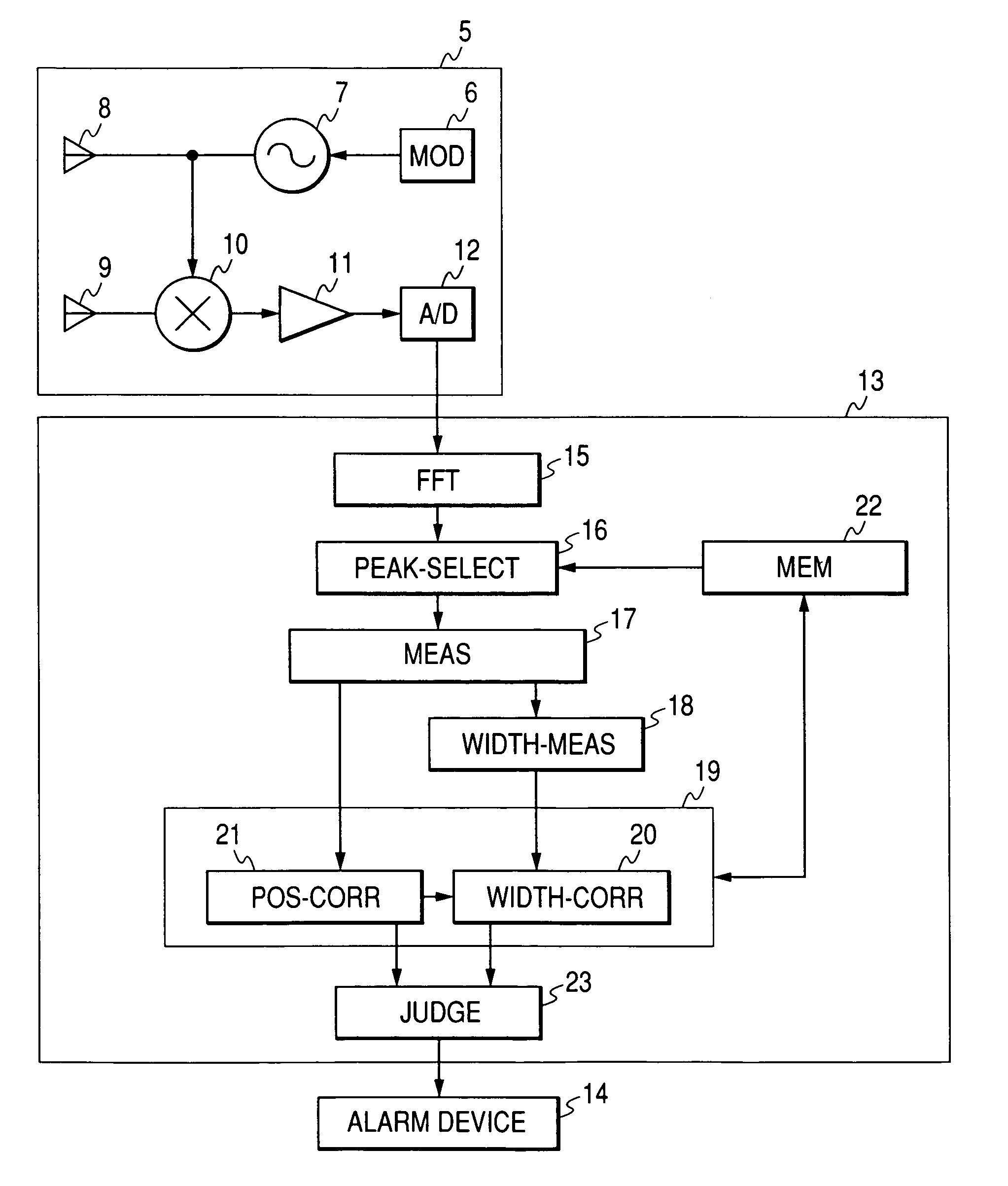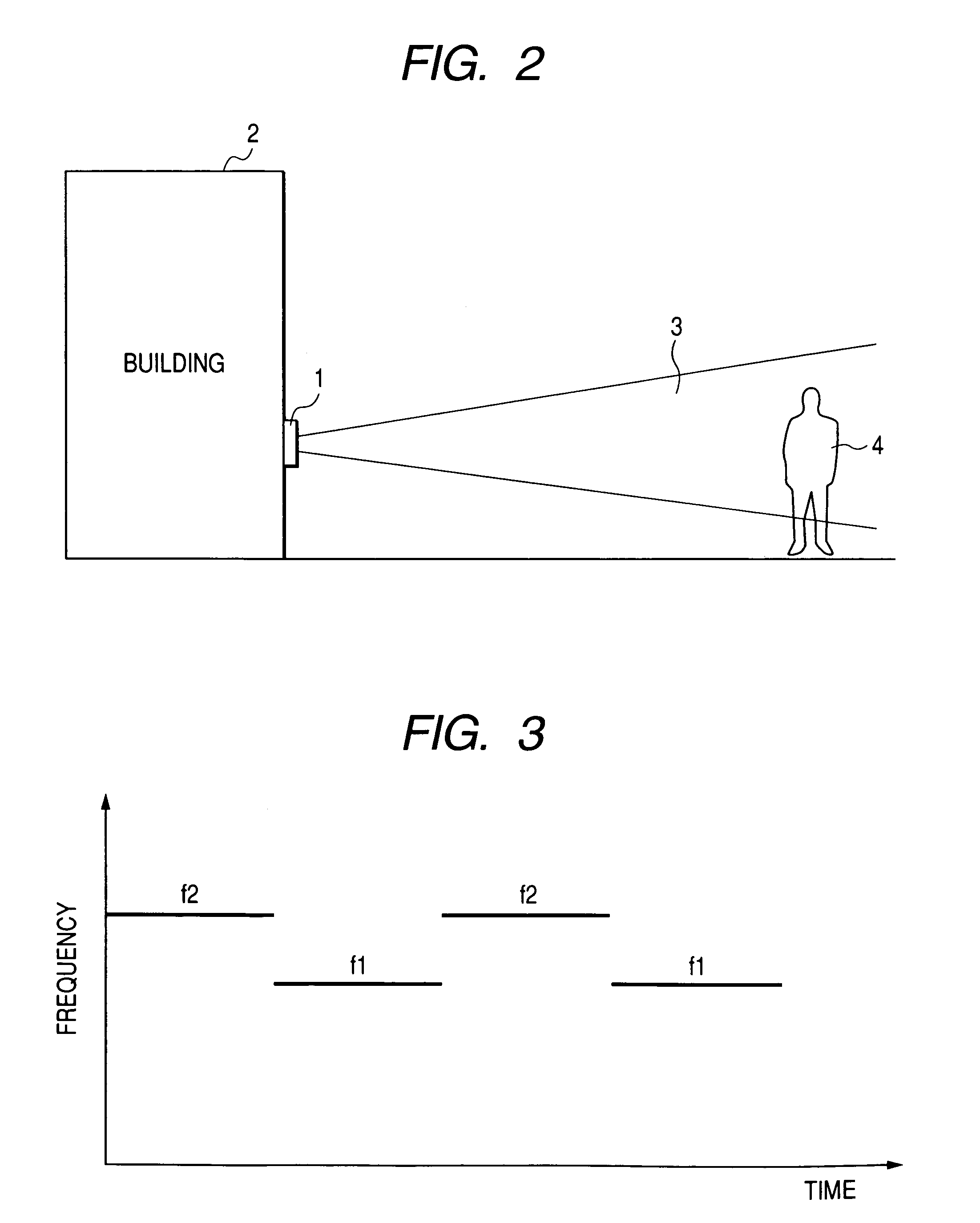Radar apparatus
a technology of radar and apparatus, applied in the field of radar apparatus, can solve the problems of low reliability of system using visible camera, inability to detect erroneously, and high cost of infrared camera compared with visible camera, so as to reduce false alarms, increase reliability, and reduce costs
- Summary
- Abstract
- Description
- Claims
- Application Information
AI Technical Summary
Benefits of technology
Problems solved by technology
Method used
Image
Examples
first embodiment
[0040]A first embodiment of the present invention is described below with reference to FIGS. 1 and 12.
[0041]First, a configuration and applications of the first embodiment of a surveillance radar of the present invention with reference to FIG. 1.
[0042]FIG. 1 is a block diagram illustrating the entire configuration of a surveillance radar of the first embodiment of the present invention.
[0043]FIG. 2 is a diagram showing how a predetermined area is monitored with a surveillance radar of the first embodiment of the present invention that is installed on an outside wall of a building.
[0044]As shown in FIG. 2, a surveillance radar 1 of the present invention is applicable to an intrusion detection system for office buildings and residences. The surveillance radar apparatus 1 is installed, for example, on an outside wall of a building 2, and detects a moving object like a human intruding into a radio emission area 3. The surveillance radar apparatus 1 uses radio waves and has an advantage ...
second embodiment
[0090]Now, a second embodiment of the present invention is described below with reference to FIG. 13.
[0091]FIG. 13 is a diagram showing an example of installing a surveillance radar apparatus so that its angle measuring direction is in vertical direction.
[0092]In other words, this is an example of installing the radar apparatus with the antenna face shown in FIG. 5 of the first embodiment turned 90 degrees
[0093]Installing in this way makes it possible to measure the vertical width instead of the azimuthal width determined in the first embodiment. That is, the height of a detected object can be measured. Accordingly, if the vertical width of a detected object is within the possible values for a human, such as between 1 m and 2.5 m, the detected object identify unit 23 judges that a human walking upright is intruding, and actuates the alarm device 14 based on the judgment.
[0094]Also, using a surveillance radar apparatus of the first embodiment and that of this embodiment simultaneousl...
third embodiment
[0096]Now, a third embodiment of the present invention is described with reference to FIGS. 14 through 16.
[0097]FIG. 14 is a diagram showing an example of using a surveillance radar apparatus of the present invention by mounting the same at the front of an automobile.
[0098]FIG. 15 is a diagram showing an example of using a surveillance radar apparatus of the present invention by mounting the same at both sides of an automobile.
[0099]FIG. 16 is a diagram showing an example of using a surveillance radar apparatus of the present invention by mounting the same at the back of an automobile.
[0100]In this embodiment, the position and width of an object 34 located in front of the automobile is measured by a surveillance radar apparatus 1, and the measurement values are input to the detected object identify unit 23. The detected object identify unit 23 judges that the detected object is an automobile if the azimuthal width of a detected object is within the possible values for an automobile,...
PUM
 Login to View More
Login to View More Abstract
Description
Claims
Application Information
 Login to View More
Login to View More - R&D
- Intellectual Property
- Life Sciences
- Materials
- Tech Scout
- Unparalleled Data Quality
- Higher Quality Content
- 60% Fewer Hallucinations
Browse by: Latest US Patents, China's latest patents, Technical Efficacy Thesaurus, Application Domain, Technology Topic, Popular Technical Reports.
© 2025 PatSnap. All rights reserved.Legal|Privacy policy|Modern Slavery Act Transparency Statement|Sitemap|About US| Contact US: help@patsnap.com



